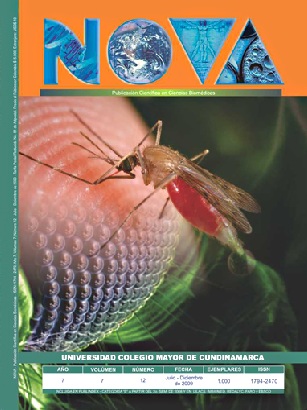Bacillus sphaericus: biocontrolador de vectores que producen malaria, fiebre amarilla y dengue
Bacillus sphaericus: vector control strategies that produce malaria, yellow fever, and dengue

NOVA por http://www.unicolmayor.edu.co/publicaciones/index.php/nova se distribuye bajo una Licencia Creative Commons Atribución-NoComercial-SinDerivar 4.0 Internacional.
Así mismo, los autores mantienen sus derechos de propiedad intelectual sobre los artículos.
Mostrar biografía de los autores
El aumento en la incidencia de enfermedades de interés en salud pública como malaria, dengue y fiebre amarilla asociado a los efectos secundarios del uso de plaguicidas químicos y la resistencia generada, ha impulsado a la búsqueda de nuevas alternativas para la erradicación de sus vectores. Una opción viable como bacteria entomopatógena es el Bacillus sphaericus, descrita por primera vez en 1904 por Neide y Meyer, quienes descubrieron una bacteria formadora de esporas, que existe en la naturaleza y que crece fácilmente tanto in vitro como en el cadáver de las larvas.
Su actividad larvicida se debe a la producción de una inclusión cristalina denominada toxina binaria A y B de 41,9 y 51,4 kDa, respectivamente, las cuales, al ser liberadas en el intestino de los insectos susceptibles en su fase larvaria y tras ser solubilizada por el pH alcalino en la porción media del intestino, activan las proteasas causando deshidratación y muerte a los vectores. Es considerada como un biolarvicida altamente potencial y eficaz para el control biológico de Anopheles spp., Aedes spp. y Culex spp. Comercialmente puede producirse por fermentación sumergida a pequeña escala con materiales proteínicos de desecho. Este producto ha sido utilizado y registrado en numerosos países de América Latina, donde se han obtenido buenos resultados después de su aplicación.
Visitas del artículo 680 | Visitas PDF 222
Descargas
- Sistema de Vigilancia en Salud Pública – SIVIGILA. Semana Epidemiológica 53 (Diciembre 28 de 2007 a Enero 3 de 2009) actualizado el 20 de Enero de 2009 y Acumulados del Año 2009.
- Romero D, Rivera ME, Cazorla FM, de Vicente A, Pérez-García A. Efect of mycoparasitic fungi on the development of Sphaerotheca fusca in melon leaves. Mycol Res. 2003;107:64–71.
- Organización Mundial de la Salud (OMS). Lucha Biológica Contra los Vectores de Enfermedades. Sexto Informe del Comité de Expertos de la OMS en Biología de los Vectores y Lucha Antivectorial. (1982). Serie de Informes Técnicos No. 679;39 .
- Charles J, Delécluse A, Nielsen-LeRoux. Entomopathogenic bacteria: from laboratory to field application. ed. Kluwer Academic Publisher. 2000 p. 253–273.
- Regis L, Silva-Filha MH, Nielsen-LeRoux C, Charles JF.. Bacteriological larvicides of dipteran disease vectors. Trends Parasitol. 2001;8:377–380.
- Colin R. Harwood, Bacillus: taxonomy. Biotechnology Handbooks: New York.1989;2;5-22.
- Kellen WR, Clark TB, Lindegren JE, Ho BC, Rogoff MH, Singer S. Bacillus sphaericus Neide as a pathogen of mosquitoes. J Invertebr Pathol. 1965;7:442-448.
- Organización Mundial de la Salud (OMS). Información técnica sobre el agente de control biológico. Bacillus sphericus cepa 1593. 1984. Serie Ecológica 10.
- Guía para la implementación y demostración de alternativas sostenibles de control integrado de la malaria en México Y América Central. ed. 1. Centro nacional de vigilancia epidemiológica y control de enfermedades. 2004.
- Realpe M, Hernández C, Agudelo C. Especies del género Bacillus. Morfología macroscópica y microscópica. Biomédica. 2002;22:106-109.
- Brock M, Martinko J, Madigan M. Biología de los microorganismos. ed 8. Madrid, España. Ed Pearson Education S.A. 2000 p.589-590.
- Hu X, Fan W, Han B, Liu H, Zheng D, Li Q et al. Complete genome sequence of the mosquitocidal bacterium Bacillus sphaericus C3-41 and comparison with those of closely related Bacillus species. J Bacteriol.
- ;190:2892-2902.
- Opota O, Charles JF, Warot S, Pauron D, Darboux I. Identification and characterization of the receptor for the Bacillus sphaericus binary toxin in the malaria vector mosquito, Anopheles gambiae. Comp Biochem Physiol B Biochem Mol Biol. 2008;149:419-427.
- Nongrados D, Castro J, Mariños C, Laguna A, Ríos R. Eficacia del Bacillus sphaericus 2362 En el control de larvas de Anopheles psudopunctipennis (THEOBALD, 1901) y Culex quinquefasciatus (SAY, 1823) en bioensayos de laboratorio. Rev Peruana Biol. 2002;7:2.
- Baumann L, Broadwell AH, Baumann P. Sequence analysis of the mosquitocidal toxin genes encoding 51.4- and 41.9-kilodalton proteins from Bacillus sphaericus 2362 and 2297. J Bacteriol. 1988;70:2045-2050.
- Kalfon A, Charles JF, Bourgouin C, de Barjac H. Sporulation of Bacillus sphaericus 2297: an electron microscope study of crystal-like inclusion biogenesis and toxicity to mosquito larvae. J Gen Microbiol. 1984;130:893-900.
- Baumann P, Clark MA, Baumann L, Broadwell AH. Bacillus sphaericus as a mosquito pathogen: properties of the organism and its toxins. Microbiol Rev. 1991; 55:425–436.
- Priest FG, Ebdrup L, Zahner V, Carter PE. Distribution and characterization of mosquitocidal toxin genes in some strains of Bacillus sphaericus. Appl Environ Microbiol. 1997;63:1195-1198.
- Baumann P, Baumann L, Bowditch RD, Broadwell AH. Cloning of the gene for the larvicidal toxin of Bacillus sphaericus 2362: evidence for a family of related sequences. J Bacteriol. 1987;169:4061–4067.
- Davidson EW, Oei C, Meyer M, Bieber AL, Hindley J, Berry C. Interaction of the Bacillus sphaericus mosquito larvicidal proteins. Can J Microbiol. 1990; 36:870–878.
- Pei G, Oliveira CM, Yuan Z, Nielsen-LeRoux C, Silva-Filha MH, Yan J, Regis L. Development of Culex quinquefasciatus resistance to Bacillus sphaericus strain IAB59 needs long term selection pressure. Biological Control. 2007;42:155–160.
- Rojas J, Mazzarri M, Sojo M, Ysrael G. Evaluación de la efectividad de Bacillus sphaericus cepa 2362 sobre larvas de Anopheles nuñeztovari. Invest. clín; 2001;42:131-146.
- Maldonado-Blanco M. Control de Aedes aegypti con microorganismos. RESPYN. 2005;6.
- Mittal PK.. Biolarvicides in vector control: challenges and prospects. J Vector Borne Dis. 2003;40:20-32.
- Reinert DJ, Carpusca I, Aktories K, Schulz GE. Structure of the Mosquitocidal Toxin from Bacillus sphaericus. J Mol Biol. 2006;357:1226-1236.
- Humphreys MJ, Berry C. Variants of the Bacillus sphaericus binary toxins: implications for differential toxicity strains. J Invertebr Pathol. 1998;71:184-185.
- Oei C, Hindley J, Berry C. Binding of purified Bacillus sphaericus binary toxin and its deletion derivatives to Culex quinquefasciatus gut: elucidation of functional binding domains, J Gen Microbiol. 1992;138:1515–1526.
- Charles JF, Silva-Filha MH, Nielsen-LeRoux C, Humphreys MJ, Berry C. Binding of the 51 and 42 kDa individual components from the Bacillus sphaericus crystal toxin to mosquito larval midgut membranes from Culex and Anopheles sp. FEMS Microbiol Lett. 1997;156:153–159.
- Broadwell AH, Baumann P. Proteolysis in the gut of mosquito larvae results in further activation of the Bacillus sphaericus toxin, Appl Environ Microbiol. 1987; 53:1333–1337.
- Baumann P, Clark MA, Baumann L, Broadwell AH. Bacillus sphaericus as a mosquito pathogen: properties of the organism and its toxins, Microbiol. 1991;55: 425–436.
- Cokmus C, Davidson EW, Cooper K. Electrophysiological effects of Bacillus sphaericus binary toxin on cultured mosquito cells. J Invertebr Pathol. 1997;69:197-204.
- Charles JF. Ultrastructural midgut events in Culicidae larvae fed with Bacillus sphaericus 2297 spore/crystal complex, Ann Inst Pasteur Microbiol. 1987;138:471-484.
- SilvaFilha, MH - Peixoto, CA Immunocytochemical localization of the Bacillus sphaericus binary toxin components in Culex quinquefasciatus (Diptera: Culicidae) larvae midgut. 2003;77:138–146.
- Singh J, Vohra RM, Sahoo DK. Purification and characterization of two extracellular alkaline proteases from a newly isolated obligate alkalophilic Bacillus sphaericus. J Ind Microbiol Biotechnol. 2001;26:387-393.
- Singh J, Batra N, Sobti RC. Purification and characterisation of alkaline cellulase produced by a novel isolate, Bacillus sphaericus JS1. J Ind Microbiol Biotechnol. 2004;31:51-56.
- Singh J. Studies on the production of alkaline protease by a newly isolated Bacillus sphaericus. PhD thesis, Punjab University, handigarh, India. 1998.
- Singh J, Jasvir RM, Vohra DK. Enhanced production of alkaline proteases by Bacillus sphaericus using fed-batch culture. Process Biochemistry. 2004;39:1093–1101.
- Almog O, González A, Klein D, Greenblatt HM, Braun S, Shoham G. The 0.93A crystal structure of sphericase: a calcium-loaded serine protease from Bacillus sphaericus. J Mol Biol. 2003 3;332:1071-1082.
- Prabakaran G, Balaraman K. Development of a cost-effective medium for the large scale production of Bacillus thuringiensis var israelensis. Biological Control 2006;36: 288-292.
- Martins CD, De Aguiar PF, Sérvulo EF. Production of Bacillus sphaericus entomopathogenic biomass using brewery residues. Appl Biochem Biotechnol. 2006;129-132:659-667.
- Nishiwaki H, Nakashima K, Ishida C, Kawamura T, Matsuda K. Cloning, functional characterization, and mode of action of a novel insecticidal pore-forming toxin, sphaericolysin, produced by Bacillus
- sphaericus. Appl Environ Microbiol. 2007;73:3404-3411.
- Tweten RK. Cholesterol-dependent cytolysins, a family of versatile pore-forming toxins. Infect Immun. 2005;73:6199–6209.
- Poopathi S, Abidha S. Novel fermentation media for production of Bacillus thuringiensis subsp. israelensis. J Econ Entomol. 2003;96:1039-1044.
- Obeta JA, Okafor N. Medium for the production of primary powder of Bacillus thuringiensis subsp. israelensis. Appl Environ Microbiol. 1984;47:863–867.
- Saalma H, Foda M, Dulmage HT, Shraby EL. Novel fermentation medium for production of delta-endotoxin from Bacillus thuringiensis. J Invert Pathol. 1983;41:8–19.
- Kuppusamy M, Balaraman K. Fed-batch fermentation studies with Bacillus thuringiensis H-14 synthesising endotoxin. Indian J Exp Biol. 1991;29:1031-1034.
- Kumar A, Sra K, Sangodkar U, Sharma VP. Advances in the biocontrol of mosquito vectors utilizing Bacillus sphaericus and Bacillus thuringiensis var. israelensis. Proc Natl Acad Sci India. 2000;1–20.
- Poopathi S, Charles JF, Nielsen-LeRoux C. Alternative method for preservation of mosquito larvae to study binding mechanisms of Bacillus sphaericus binary toxin. J Invertebr Pathol. 2002;79:132-134.
- Poopathi S, Kumar KA. Novel fermentation media for production of Bacillus thuringiensis subsp. israelensis. J Econ Entomol. 2003;96:1039-1044.
- Berti J, Ramírez X, González J, Herrera M. Evaluación de la efectividad de Bacillus sphaericus contra larvas de Anopheles aquasalis Curry (Diptera: Culicidae) en criaderos naturales del estado Sucre, Venezuela. Entomotropica. 2002;17:1-5.
- Blanco S, Martínez A, Cano O, Tello R, Mendoza I. Introducción del Bacillus sphaericus cepa-2362 (GRISELESF) para el control biológico de vectores maláricos en Guatemala (2000). Rev Cubana MED TROP 2000;52:37-43.
- Mulla MS, Darwaseh HA, Davidson EW, Dulmage HT, Singer S. Larvicidal activity and field efficacy of Bacillus sphaericus strain mosquito larvae and their safety to non target organism. Mosq News 1984; 44:336-342.
- Montero G, Díaz M, Marrero A, Castillo F. Resultados de las aplicaciones en pilotaje del biolarvicida Bacillus sphaericus 2362 en criaderos de mosquitos del municipio de Santa Cruz del Norte (Prov. La Habana). Rev. Cuba Med Trop. 1991;43:39-44,
- Rivera P. Evaluación de la efectividad biolarvicida y residual de Bacillus sphaericus (cepa 2362) para el control de Anopheles albimanus en la costa del lago Xolotlan, Managua, Nicaragua, 1995. Rev Nicar Entomol. 1997; 2:7-14.
- Villareal LI. Bacillus sphaericus: para el control de vectores de enfermedades tropicales. Rev Latinoam Salud Saneam Ambient 1995;1:12-4.
- Organización Panamericana de la Salud (OPS). Empleo inocuo de plaguicidas. Noveno informe del comité de expertos de la OMS en biología de los vectores y lucha antivectorial. Washington, D.C. Serie de Informes Técnicos; No. 720. 1985:26-27.
- Priest FG. Biological control of mosquitoes and other biting flies by Bacillus sphaericus and Bacillus thuringiensis. J Appl Bacteriol. 1992; 72:357–369.
- Thiery I, Back C, Barbazan P. Sine`gre G. Application de Bacillus thuringiensis et de B. sphaericus dans la de´moustication et la luttecontre les vecteurs de maladies tropicales. Ann Inst Pasteur Actual. 1996; 7:247–260.
- -------------------------------------------------------------------------------
- DOI: http://dx.doi.org/10.22490/24629448.433





